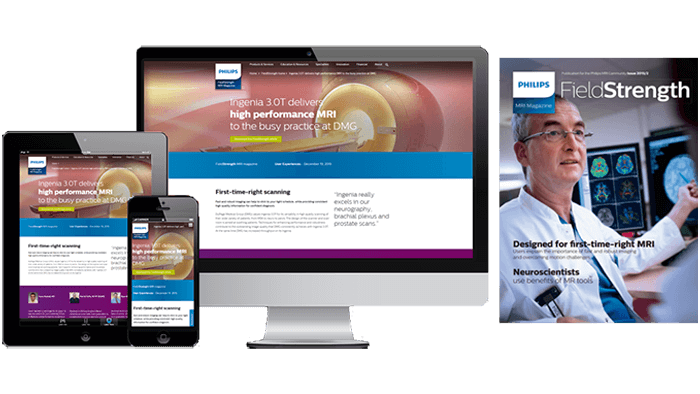FieldStrength MRI magazine
User experiences - February 2018
Share this article:
Patients really like MRI In-bore solutions, and case studies on reduced need for sedation and less rescans
Recent studies by hospitals in Denmark, Japan and Germany demonstrate the broad impact of enhancing the experience of patients in the MRI scanner. It helps the centers stand out in their market, as satisfied patients and referring physicians spread the word. With an improved In-bore Experience, for instance with In-bore Connect, image quality benefits and reductions in rescans* are reported, because a relaxed patient is less likely to move. Next to that, an impressive 80% reduction in the need for sedation is found in a case study at one center in Germany.
“It is a quite easy way to really, significantly improve the experience for our patients”

Yoshitada Masuda, RT, PhD
Chief Radiological Technologist at the Department of Radiology, Chiba University Hospital, Chiba, Japan.
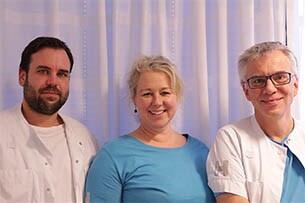
From left to right: Jonas Bovin, Jeannette Brus Mortensen and Kristian Fogh, radiographers at the MRI department of Herlev Hospital, close to Copenhagen, Denmark.
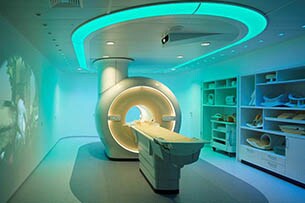
Dr. Jan Kesseböhmer Radiologist at Radiologisches Zentrum am Kaufhof, Lübeck, Germany
Designing the patient’s experience during MRI
To improve on this, Philips provides a holistic approach to help MRI patients feel comfortable and relaxed. During the scanning, an audiovisual experience and additional features can distract and inform patients. Users have collected data that illustrates how large the effect can be.
For patients, an MRI exam can be a long, stressful, noisy, experience. Feelings of anxiety and discomfort can make it hard to remain still and complete the procedure. This can lead to motion artifacts in the images, or to the need for rescans and even exam cancellations. Some patients need sedation to successfully undergo MRI.
“It is a quite easy way to really, significantly improve the experience for our patients”
Majority of patients would recommend a scan with In-bore Connect
A multi-center study was conducted to capture the effect of Inbore Connect on patients and staff. The participating centers were Herlev Hospital in Denmark, using an Ingenia 3.0T system with In-bore Connect and Chiba University Hospital in Japan, using an Achieva 1.5T dStream and Ingenia 3.0T both with In-bore Connect.
Data from 1,217 patient scans were collected before and after installation. All conditions were kept equal except for the In-bore Connect option being on or off. Additionally, almost 200 patients completed a questionnaire on their experience during the MRI scan.
Dr. Yoshitada Masuda of Chiba University Hospital found that “Before using In-bore Connect, 88% of our patients indicated they were not satisfied with their MRI experience, and that made a big impression on us. After installing In-bore Connect, we found that this really helps patients have a calmer, better experience, especially those who are nervous.”
The patient surveys from Herlev and Chiba show that 84% of the patients feel calmer because of the In-bore Connect. A clear majority of patients say they would recommend the MRI system with Ambient experience and In-bore Connect to others needing an MRI (NPS 60).
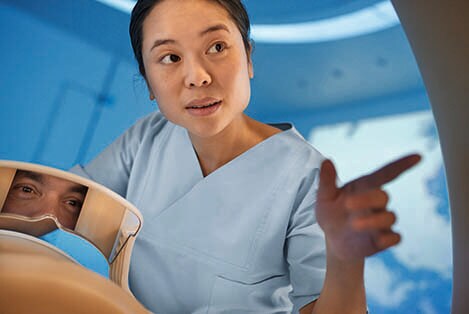
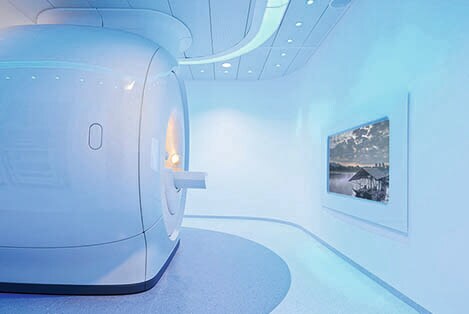
Entertainment and guidance in the bore to relax patients
Patients lying in an MRI scanner with In-bore Connect undergo an immersive experience. It offers patient entertainment while involving and informing them with a progress bar, breath-hold guidance and AutoVoice. It can be also combined with up to 80% noise reduction by using ComfortTone.
"Many patients say they were really glad they could see how much time the scanning still takes"
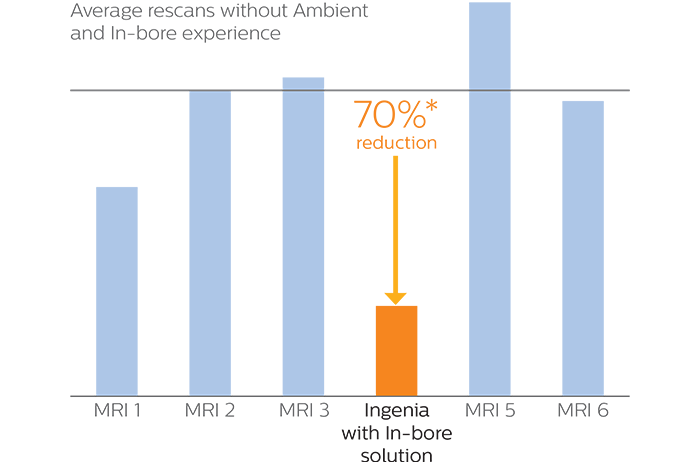
Improving MRI experience can reduce the need for repeat scanning
* Compared to the average of the other 5 Philips MR scanners without Ambient and In-bore Experience. Results from case studies are not predictive of results in other cases. Results in other cases may vary.
In an earlier study, Herlev Hospital had already been scanning with the initial version of In-bore Experience in their Ingenia scanner room with Ambient Experience. In a study performed in 2015, they demonstrated a 70% reduction in the number of interrupted scans on their Ingenia 3.0T with In-bore solution compared to the average of their five other Philips MRI scanners.
Improving MRI experience can reduce the need for repeat scanning

In an earlier study, Herlev Hospital had already been scanning with the initial version of In-bore Experience in their Ingenia scanner room with Ambient Experience. In a study performed in 2015, they demonstrated a 70% reduction in the number of interrupted scans on their Ingenia 3.0T with In-bore solution compared to the average of their five other Philips MRI scanners. * Compared to the average of the other 5 Philips MR scanners without Ambient and In-bore Experience. Results from case studies are not predictive of results in other cases. Results in other cases may vary.
Entertainment and guidance in the bore to relax patients
The current multi-center study focused on the effect of In-bore Connect on top of that previous finding. In-bore Connect is designed for patients feeling a sense of isolation while in the scanner, maybe wondering how much longer the examination will still take, feeling alone, or not knowing why the noise stopped.
The MRI technologists Kristian Fogh, Jonas Bovin and Jeannette Brus Mortensen at Herlev Hospital have noticed that their patients feel significantly more comfortable with the In-bore Connect. “The progress bar is very much appreciated by our patients. Many say they were really glad they could see how much time the scanning still takes before the examination is completed. Especially patients who have been in an MRI scanner before recognize this as a big improvement”, says Mr. Fogh. “In-bore Connect is making it easier to give patients a good experience here.”

The progress bar is displayed on the video screen that the patient is watching while in the scanner. It shows the patient in real time how the scan progresses. So, it helps to give patients a sense of time during examination.
The majority of patients stated that they find it important to understand how long the examination is still going to take. No less than 84% of the surveyed patients indicated that the progress-bar helped them to feel calm.
Breathhold guidance can make a difference for completing a scan
The multi-center study results show that patients find it significantly easier to be compliant with breath-hold instructions. “After a scan, patients often say that it helped them to see how long a breath-hold will still last,” says Mr. Fogh. “Seeing that you only have to hold breath for two more seconds, for example, can help a lot in achieving it. I consider this is a great improvement for achieving a successful breath-hold scan.”
According to Dr. Masuda, also the patients at Chiba really appreciate the sense of time they get from both the progress bar and the visual breathhold guidance. Also AutoVoice contributes, as it announces table movements and next scans, in their own language. “It's a comprehensive solution. All features together help achieve this effect,” says Dr. Masuda.

The breath-hold guidance function coaches patients through the breath holding that is needed for some scans. It shows a patient when to start and how long he or she still needs to hold breath.
“Seeing that you only have to hold breath for two more seconds, can help a lot in achieving it”
"We have often seen the large effect it can have on a patient entering the MRI room''
In addition to patients, also MRI staff benefits from the Philips In-bore Experience
According to Mr. Bovin, In-bore Connect features are not only appreciated by patients, but also by the MRI staff. “With the progress bar, breath hold guidance and AutoVoice, the patient stays informed all the way through the examination, and at the same time this really helps me in my daily work. I truly like that I can focus on other tasks during a scan, such as exam planning, without interruptions for talking to the patient all the time. I feel more relaxed, because I know that the scanner is consistently informing my patient throughout the whole examination. It makes me prefer working on this scanner as it is a bit easier than on our other scanners without those features.”
“I actually appreciate the fact that every patient receives the same amount and quality of communication with the progress bar and AutoVoice, regardless of which radiographer is performing the scan, or his or her mood,” Ms. Mortensen adds. “Because the system assists the technologist in communicating to the patient, even on a bad day or in a busy shift our staff is able to keep their patients informed equally well.”
Experiences are similar in Japan. “Our technologists like to frequently update the patient during the scanning. Knowing how long the examination will still take is important for the patient, but due to their many tasks, a technologist can sometimes update patients less frequently than they would like. That’s why In-bore Connect is very much appreciated by our patients as well as our staff.”
Mr. Bovin mentions that the Herlev technologists prefer to work with the Ingenia system if there is a choice. “It’s the combination of the big bore, the ease of use of the coils, as well as the lighting and the In-bore Experience. The scanner with In-bore Connect is definitely the preferred scanner among the techs here.”
"The progress bar and AutoVoice really help me in my daily work"
Good results with difficult patients
“We have often seen the large effect it can have on an anxious patient entering the MRI room. I remember one patient that felt claustrophobic and reluctantly came to his MRI appointment, but afterwards he said that he had an excellent experience,” says Dr. Masuda.
In Japan, patient experience is also important because it can benefit cost effectiveness. “When a patient is relaxed, we can more easily obtain good image quality than with a nervous, restless patient who is more likely to move. Patient motion causes artifacts or interrupted scans, leading to repeat scans or even rescheduling the exam, which costs additional time. We see every day how In-bore Connect helps to relax patients, allowing our technologists to obtain high quality MRI images.”
Building reputation and referrals with focus on patient satisfaction
To the team at Herlev Hospital it is clear that In-bore Connect increases patient satisfaction significantly. “Most of our patients feel that the experience they had in the scanner with In-bore Connect is much better than their previous experiences. Especially patients feeling worried were glad to be able to look out at a screen, and see the progress. Patients indicate that this helps them relax,” says Mr. Fogh
“Patient satisfaction is a key goal at our hospital, which is why we invested in improving the patient experience during MRI. And funny thing is, that it is a quite easy way to really, significantly improve the experience for our patients,” says Mr. Fogh. And Ms. Mortensen adds “Our name is on the Danish map, we are known for having this focus and this In-bore solution in Herlev Hospital. Some patients we scan have travelled quite far.”
Also at Chiba University Hospital, patients are significantly more satisfied when undergoing MRI with Ambient Experience and In-bore Connect. “Our patients are telling referring physicians about their experience with In-bore Connect and asking for that scanner for their MRI examination.” says Dr. Masuda. “And we are receiving many visits from colleagues from other hospitals that are interested in acquiring it at their own institutions.”

"We found that In-bore Connect really helps patients have a calmer, better experience”
Yoshitada Masuda, RT, PhD

"It is a quite easy way to really, significantly improve the experience for our patients”
Jonas Bovin

"Our name is on the Danish map, we are known for having this focus and this In-bore solution in Herlev”
Jeannette Brus Mortensen

"Patients are asking their physicians if they can have In-bore Connect during their MRI examinations”
Kristian Fogh
"We found a significantly lower need for sedation among patients scanned on the Ingenia with In-bore Experience"
Can enhancing the MRI experience reduce the need for patient sedation?
The Radiologisches Zentrum am Kaufhof (RZK) in Lübeck, Germany, is using an Ingenia 1.5T S with In-bore Experience solution in addition to three 1.5T MRI systems from other brands. The center’s MRI case load is basically covering the whole spectrum, but the largest fraction is musculoskeletal imaging. The Ingenia system is in operation since 2015 and, according to Dr. Jan Kesseböhmer, patient comfort had been a main requirement for selecting that system, in addition to energy efficiency and the need for up-to-date imaging capabilities.
Dr. Kesseböhmer recognized the opportunity to not only differentiate the practice from competitors, but also provide a high degree of patient comfort during scanning with the Philips Ingenia 1.5T S with its In-bore solution. “It allows us to adhere to – or even raise – our high standard of patient comfort. The room lighting and the In-bore Experience provide a relaxing environment through an immersive video experience during the scan, that we expected to enhance patient comfort and cooperation, as well as improve workflow. Ingenia 1.5T S also offers the possibility to perform scans with reduced noise.”
A better overall impression and reduced anxiolytics use
Six months after installing the system, a retrospective survey
“The retrospective preliminary data also suggested that we were using much less anxiolytic sedative medication** for patients in the Ingenia MRI system with
"Our patients were calmer and more compliant”
Our patients were calmer and more compliant
Sedation is a commonly used approach to allow patients to undergo an MRI examination without major patient movement that can deteriorate image quality. Dr. Kesseböhmer distinguishes several scenarios of patients requiring sedation in order to successfully complete an MRI examination. “For patients with claustrophobia or a history of needing sedation in the magnet, we know beforehand that they will need sedation. Secondly, there are patients who get very anxious when entering the MRI room and are offered sedation right at that moment. A third, and fortunately small group, are patients who start a scan but then appear incapable to complete it, so that we have to cancel the examination and try again with sedation.”
The need to sedate patients can pose significant operational disruptions and administrative burdens for imaging centers. Evaluating whether a patient needs sedation takes time and additional handling. The risk of respiratory depression imposes the need for monitoring a sedated patient during the scanning. For the patient, there are also practical considerations, such as dizziness, nausea and the advice to not drive directly after their MRI exam. These factors can negatively affect both the patient and staff experience, and raise costs.
Decreasing the need for patient sedation with In-bore Experience at RZK in Lübeck
The results of the retrospective study made Dr. Kesseböhmer decide to conduct a prospective study, to further compare the Philips Ingenia 1.5T S with In-bore Experience with the institution’s two other 1.5T systems. All three systems have a 70 cm wide bore diameter.
“We started this study to confirm our retrospective observation of the impact of the Philips system, and we again found a significantly lower need for sedation among patients scanned with the Philips system. The need to use sedation was shown to be reduced by 80% versus the average of the two other wide-bore 1.5T MRI systems.[5] We discovered that our patients were calmer and more compliant when scanned using the Philips MRI In-bore Experience.”
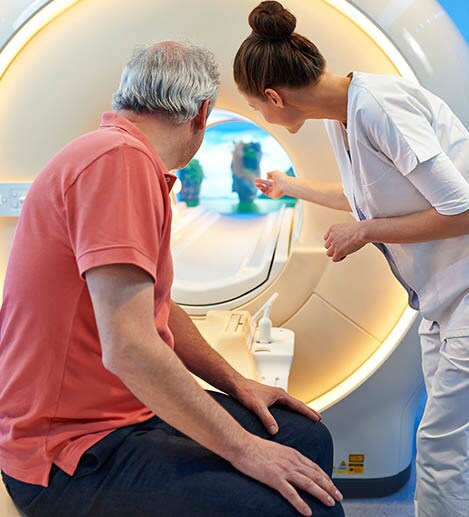
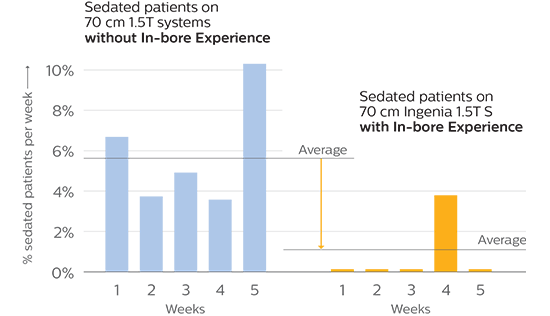
The number of sedated MRI patients was 80% lower with Inbore Experience in this case study
The study results show a significant (p = 0.005) decrease in the percentage of patients who required sedation** with the In-bore Experience, a substantial 80% difference.
The number of sedated MRI patients was 80% lower with Inbore Experience in this case study

The study results show a significant (p = 0.005) decrease in the percentage of patients who required sedation** with the In-bore Experience, a substantial 80% difference.
"Reflecting on our goal to differentiate ourselves, I think this has really been achieved"
Achieved goals and further observations
The effect that In-bore Experience has on patients can be amazing, according to Dr. Kesseböhmer. “We had a 7-year-old boy who was very anxious and shy when he came here for an MRI scan. However, after being scanned in the system with Inbore Experience, he was totally changed. He was so elated and interested, and was making suggestions about lengthening the movie, and so on. He wasn’t thinking anymore about why he was there, but about how great the MRI machine was. For us, having a good acceptance of the MRI without sedation is really the clue to examining children.”
Another big impact is that patients seem to feel less isolated and left alone in the magnet. “Patients sometimes wonder what’s coming, for example when there is a pause due to preparing a next sequence. But with the In-bore Experience, patients continuously have information about the study, how long the next scan will take, and whether the table is going to move.
Reflecting on our goal with this scanner, to differentiate ourselves – I think this has really been achieved, with the biggest impact being that In-bore Experience for the patient. I think this is something special, and I’m pretty sure that patients are talking about it. And we now know that use of sedation is not an inevitability in MRI and this is great news for our patients.”
References
2. Mélendez JC, McCrank E. Anxiety related reactions associated with magnetic resonance imaging examinations. JAMA. 1993;270:745-47. 3. USA Customer Survey (118), September 2015, data on file. 4. Relaxed patients, reduced motion, increased productivity. Philips FieldStrength, https://www.philips.co.uk/healthcare/education-resources/publications/ fieldstrength/mri-patient-experience-to-help-reduce-motion 5. Kesseböhmer J. Can enhancing the MRI In-bore Experience reduce the need for patient sedation? Diagnostic Imaging Europe 2017
1. Andre JB, Bresnahan BW, Mossa-Basha M, Hoff MN, Smith CP, Anzai Y, Cohen WA. Towards quantifying the prevalence, severity, and cost associated with patient motion during clinical MR examinations. J Am Coll Radiol. 2015;12:689-95.
